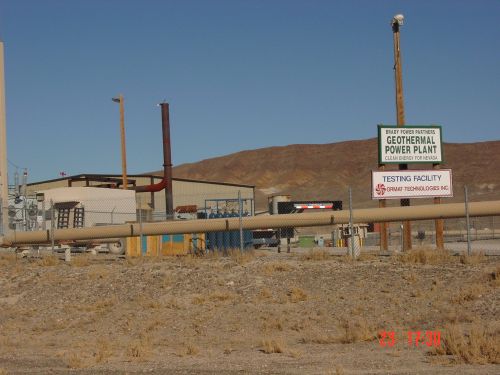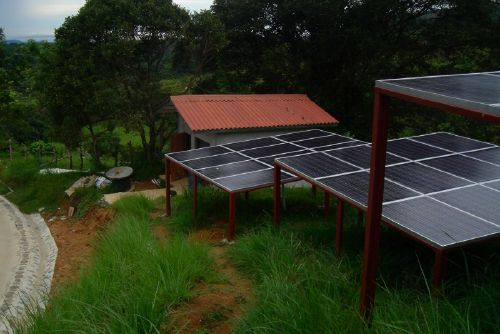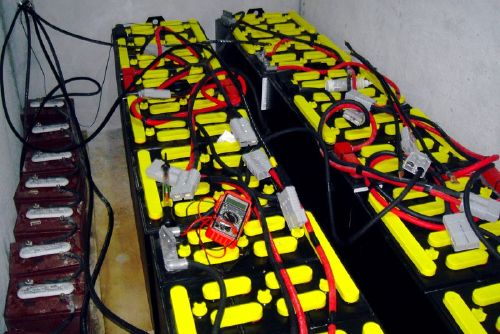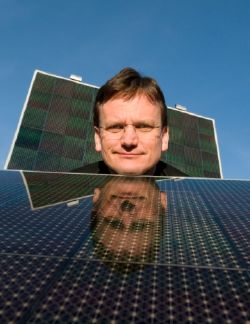Archive for December, 2007
Seeking Alpha on Ormat

Photo Credit: Mike Harding
Via Seeking Alpha:
On December 17, Ormat Technologies Inc. (NYSE:ORA) announced a 20-year agreement with Southern California Edison for the sale of energy from ORA’s 30 megawatt plant at Imperial Valley, CA, that is expected to come on line by mid 2012. On December 18, Ormat announced the execution of agreements in the 340 MW Sarulla Geothermal Project in Indonesia where Ormat will design and supply the power generating units. These agreements indicate that ORA will not only remain as a leading geothermal power producer in US, but is also expanding its international presence.
…
The stock has been making good gains (almost 70%) since June ’07 lows. This gain has resulted in the stock breaking out of a prolonged consolidation that extended for almost a year and a half. The lofty PE (95 and 45 – Trailing and Forward respectively; Source: Yahoo Finance) makes the stock appears expensive at current levels. Nevertheless, considering the business opportunities available for ORA, any dip on the stock can be a buy opportunity for short and medium-term players. The Reno, NV based company’s policy of targeting an annual payout ratio of at least 20% of its net income (ORA has been distributing regular quarterly dividends for the last three years) makes the stock attractive for those who want a steady stream of income.
We agree that Ormat is an impressive player in the geothermal space, and the largest and most stable pure play. However, we believe the stock is tremendously expensive (even accounting for prospects and growth) at present levels.
One aspect of the company not covered in the article is the split between the equipment and electricity generation segments. We believe the equipment and electricity operations segments in the same company will prove to be problematic strategically as customers of the equipment segment increasingly see the electricity segment as a competitor. The equipment segment is about 20% of the company’s revenue and is “lumpy” from quarter to quarter. The electricity segment is where the growth is occurring. We wonder if it might not make more sense to spin out the equipment business as an “arms” dealer to all, including a separate Ormat run electricity generator.
All that being said, geothermal is the renewable that has yet to be discovered in the mainstream and it may be that there is substantial upside still possible in the stock given the overall heat of the segment. As an additional data point, traditional electricity generators trade at a PE of around 15 (Source: Yahoo Finance.)
Disclosure: The author holds no position in Ormat.
Multi-dimensional harvest in Panama
A colleague of ours has been exploring Panama recently and brought Rancho de Caldera to our attention. It’s a small resort set in the mountains of Panama with nine cabins and it’s largely energy independent. Despite being close to a volcano, geothermal systems are not part of the harvest system (even for heating/cooling), rather it is solar, wind, and micro hydro harvest backed by a battery bank and supplemented by a generator. The operator estimates that between 4.5 – 5 kW of electricity are generated per hour (1 kW from hydro/wind and the balance from solar.)

Photo Credit: Rancho de Caldera

Photo Credit: Rancho de Caldera
$1 per watt solar

Photo Credit: Nanosolar Blog
Last week, much ink (pun intended) was spilled regarding Nanosolar’s announcements regarding their new printed solar cell technology. The first 3 panels were presented one to stay at company HQ, one to the San Jose tech museum, and one to be auctioned by eBay (not!, read the blog on that story…)
We’ve been a bit bearish on photovoltaic solar for two primary reasons: cost and capacity. If the breakthroughs claimed by Nanosolar prove out in practice (there is precious little technical information available about the printed solar cells performance) then it’s possible the cost aspect of our bearish outlook has been cracked. The pricing places these panels in the capital cost class of plain coal (as opposed to “clean coal”) and natural gas fired technologies. That is significant.
The capacity aspect is still problematic, here in North America around 40 degrees north, one can expect an average capacity factor in a good solar location to come out at 24%; peaking at ~36% in the summer and bottoming out at ~12% in the winter. When looking at solar relative to fossil fuels, hydro, nuclear, and geothermal, all baseload technologies, this aspect is still a barrier. However, at the new price point, the major advantage solar pv has is in small, distributed installations which are impractical for the baseload technologies and that advantage can now be maximized.
The missing link is the technical details. State-of-the-art pv loses around 1% efficiency per year of use, is that true of Nanosolar? What is the conversion efficiency? Silicon-based pv cells have gone north of 40% in the lab and are commercially available around ~20%. Thin film cells check in around 10%. Based on what has been disclosed about the technology it’s likely to be closer to thin film than silicon in efficiency. Until these details become clear and the breakthrough can be judged publicly against known technology, it’s exciting potential. We’ll be anxiously waiting to see the details.
Flawed Law
Earlier this week President Bush signed the Energy Bill sent to him by Congress. Major components to the bill were gutted by the Senate at the last minute, killing long-term production tax credits and renewable portfolio standards, and keeping the expensive and unnecessary oil subsidies. (Really, when a single company in the segment throws off $10 billion in profits a quarter, do they really need subsidies?)
The major achievement of the bill is to the increase in fuel standards to an aggregate of 35 miles per gallon, which means that in the year 2020 we’ll catch up to the rest of the world in fuel efficiency. That is, if the rest of the world stood still over the next 12 years. An nice side benefit is that Congress did agree to fund geothermal R&D to the tune of $95M, which is quite an improvement from $0. So there may be a baby step that this law provides, but on balance, it doesn’t really accomplish much.
$130M market cap for Calpine
Things continue to look grim for Calpine, the independent power producer struggling to emerge from bankruptcy protection. Squeezed between declining margins (real terms, not necessarily GAAP terms with special charges coming off the books etc.) demanding creditors, one has to wonder if Calpine will emerge from the proceedings now.
Earlier this week the company announced a reduction of their credit facility by $400M (the entire facility was $8B) and a revaluation of the company when it emerges from bankruptcy of $18.95B. Creditors believe the valuation should be north of $24B leaving a significant gap. The bankruptcy court has approved the revised plan and the company should emerge in January. But, this was true in June too and didn’t happen.
Why do we care? Calpine’s portfolio is dominated by natural gas-fired power plants. But, a small and profitable segment of the company is comprised of the 19 plants located in The Geysers region of California producing about 750MW of clean power. We’re very interested in seeing those valuable assets protected and not have them sink with the Calpine ship.
Note: The issue is gaining today, but the market cap is still sub-$200M down from ~$2B in June.
Disclosure: The author holds no position in Calpine (though he did consider it as a speculative investment at one time.)








